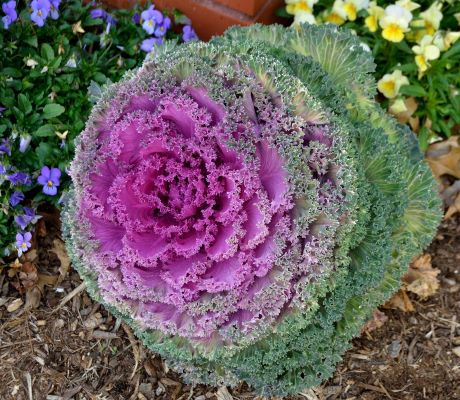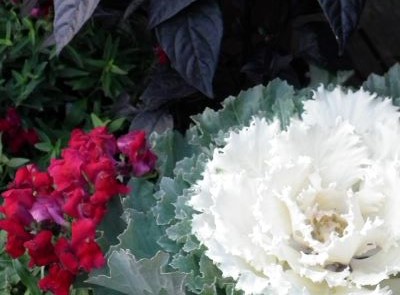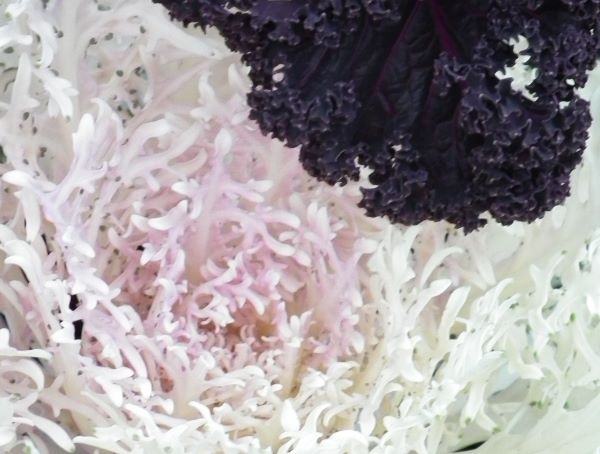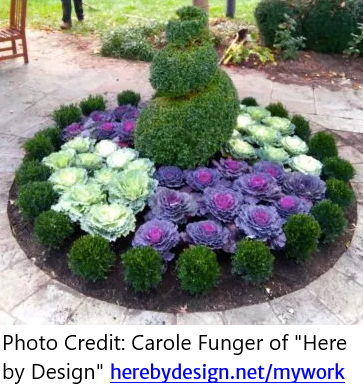If your cold-weather garden is dreary, consider adding ornamental kale for a showy pop of red, purple, pink and white. When done in groupings, these lovely plants make a striking display with their bold, multicolor foliage. They do best in cool weather so in most places they belong in the fall garden though they can be planted in spring in cooler climates. Cooler weather also promotes greater leaf color--spring plantings in warmer zones will benefit from some afternoon shade.
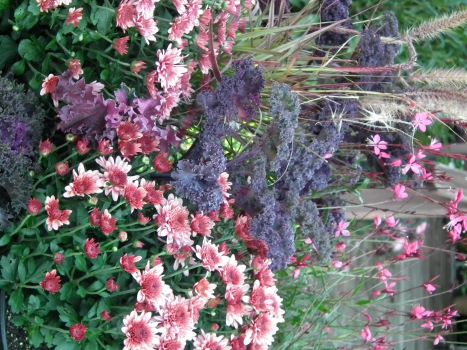
Kale, cabbage--what's the difference--and can I eat them?
At the nursery, you'll see these called either kale or cabbage, depending on the look of the foliage, but botanically they are all kale. Plants labelled as kale are types with very frilly-edged, serrated, or lacy leaves. "Cabbage" has wide, wavy leaves.
Kales are part of the Brassica family, which also includes broccoli, cauliflower, mustards and turnips. You may also see them referred to as cruciferous vegetables or cole crops. The ornamental kales, despite their closely related tasty cousins, are bred for their decorative leaves rather than taste, and are rather bitter. This is helpful in that in many cases deer may leave them alone--at least for a while.
You will also see completely edible and delicious varieties marketed with the ornamentals, however. Extra curly 'Red Bor' and 'Winterbor,' and Lacinato (Dinosaur) kale are often found this way. Note that these will have been grown as ornamentals, which means who knows what chemicals have been applied. Unless you are growing your own, you might want to leave those in the garden and off your dinner plate.
Purchased plants can be placed in the ground as soon as they're available--usually September in cooler climates. In warmer climates you're not likely to see them until a while later as it's more difficult for growers to get them to fatten and color up until temperatures cool off a bit.
How can
I grow them myself?
If you'd like to try your hand at growing your own you'll need to start seeds 8-12 weeks before your expected first frost date, depending on the ultimate size of the plant you're attempting to achieve. It can be difficult to produce that familiar squat, dense plant you'll find at the nursery, due to warm temperatures during the early growing period. Try to find the coolest growing spot you can--you may benefit from starting plants under good lights inside where they can be air-conditioned along with you.
Be sure to use a starter cell that will allow roots to grow without coiling or cramping during this time--this will severely restrict plant growth if this occurs before transplanting. You can transplant when your babies have about 4-6 true leaves and temperatures have cooled a bit. Higher soil temperatures and dry soil can cause damage and restrict root development.
Dry soil, warm daytime temperatures, and lack of nitrogen can cause the lower leaves to yellow and drop. Fertilize weekly with a 20-10-20 calcium nitrate/potassium nitrate based fertilizer with micronutrients--adequate magnesium and calcium are important to keep plants as compact as possible and to prevent tip burn that may occur in hot, humid weather. All nitrogen is not the same--check the label for ammonium or urea based nitrogen, and look for less than 30% of N from these sources to reduce stretch. You can cut back about half on fertilizing once coloring begins. Purchased plants may also benefit from fertilizing if you notice yellowing and leaf drop.
Why is my kale green and leggy?
Coloring usually begins after about 2 weeks of days at 65-75 degrees with nights around 55 degrees. Even plants that have started to color can revert back to green with daytime temperatures at or over 77 degrees. Most will color again with a couple weeks of 55 degree nights, but some varieties may not.
No matter how hard you try, warm spells may cause the stems to elongate excessively. It's ok to plant them up to the lowest layer of leaves--you'll just have to dig a deeper hole. Sometimes taller ones that have retained all their leaves can be used to good effect in groupings or container gardens. Growers usually apply growth regulating chemicals to keep their crops shorter, so you may have difficulty producing a similarly compact, dense plant.
How long will they last?
Cold temperatures and snow don't cause much trouble. Frequent freezing and thawing and ice storms will turn them into a mushy mess. Most will make it through the spring, "bolting" or sending up flowers as temperatures warm. The yellow flowers are actually sort of attractive, borne at the top of tall, thin stems.
What's eating holes in my kale?
If you've grown cole crops before, you're probably familiar with the likely pests, including cabbageworms, cabbage loopers, flea beetles, caterpillars, thrips, slugs, and aphids. Most can be excluded during the growing phase with a fine mesh covering. Slugs and snails can be deterred with cabbage collars impregnated with copper, or with a dusting of diatomaceous earth.
Once in the landscape, plants may need to be treated if damage is extreme. Curling or distorted leaves likely means thrips or aphids, which can be combatted with an insecticidal soap. If holes are appearing, look for small caterpillars deep between the leaves--for these, spraying with a product containing Bt (Bacillus thuringensis) is safe and quite effective to reduce and even prevent caterpillar damage. If you see small white butterflies hovering around your plants (cabbage whites), bad things are likely to happen, so start checking for eggs and caterpillars right away.
How do I use them?
You don't need to worry about sun or shade too much, as long as the plants have reached the size you need. As long as it's not heavy or deep shade they'll usually be fine, but yes, they are technically a full sun plant. Remember that in winter the sun moves lower and toward the west, and deciduous trees will no longer block the light, so what was once shaded may now be sunny.
Kale won't grow much wider after you buy it, so purchase the size you need. If temperatures turn warm, it may grow UP, of course. With the proper climate height for most is about 6 inches, width about 10-12 inches.
Nursery plants in 4.5 or 6" pots are a perfect size for window boxes and small to medium containers. If your hanging baskets aren't too high you can make a lovely planting with a tall kale (or grass) in the center surrounded by kale of another color or variety. They work well with grasses, mums, asters, pansies, and other fall plants. If you want to think ahead to the holidays, try white varieties with red violas around a small upright evergreen.
Larger kale are beautiful fronting a bed of evergreens or interspersed with liriope or other small evergreens, taking the place of your summer annuals. Alternate sections of kale with sections of pansies or violas for vibrant color. Massed in concentric circles of different varieties or colors, or in other geometric designs, they create a fascinatingly showy display. Of course, as they are relatively short they need to be placed near the front of beds and borders.
For more impact tilt them on a slight angle when planting to show more of the face of the plant--this can also reduce water trapping between the tightly spaced leaves. You can plant them fairly close as they won't grow much, but it's best to leave a bit of space for air circulation to lessen the chance of mildew.
Which variety do I want?
Red or purple varieties in full color usually have dark purple outer leaves with reddish-purple or magenta-purple centers. Pink types have lighter, purply-gray outer leaves with rosy-pink centers, while whites have bluish-green leaves and white centers, often with a smaller central area of light pink. Other than that, it's up to you! We will note a few that in our experience stay in good condition noticeably longer than others--in our area we often experience wide temperature fluctuations and freeze/thaw cycles that make it hard for these plants to get effectively winterized.
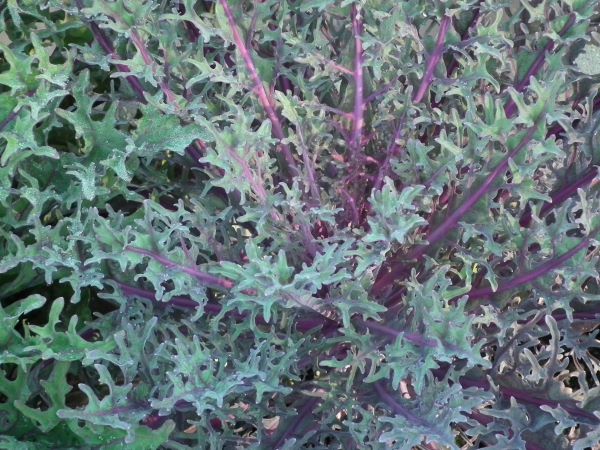 'Peacock' series - great thriller plants for containers, with a fountain of narrow, heavily serrated, feathery leaves. Red has a bright magenta-red center with dusky, dark purple outer leaves when in full color. Even early on the bright purple stems attract attention. White is green with a white center, usually with a smaller light pink central core. Adds wonderful texture and verticality for containers, as these are taller plants with a height and spread from 12-24 inches. They are especially good in wetter climates (and automatically irrigated beds) as water runs through the leaves and does not remained trapped in the center of the plant, which can induce rotting. These hold up better than other varieties here in typical Mid-Atlantic winters.
'Peacock' series - great thriller plants for containers, with a fountain of narrow, heavily serrated, feathery leaves. Red has a bright magenta-red center with dusky, dark purple outer leaves when in full color. Even early on the bright purple stems attract attention. White is green with a white center, usually with a smaller light pink central core. Adds wonderful texture and verticality for containers, as these are taller plants with a height and spread from 12-24 inches. They are especially good in wetter climates (and automatically irrigated beds) as water runs through the leaves and does not remained trapped in the center of the plant, which can induce rotting. These hold up better than other varieties here in typical Mid-Atlantic winters.
'Coral' series - very thick, sturdy leaves, less serrated than Peacock, generally broader than other varieties. 'Coral Queen' has deep purple outer leaves with a reddish-purple center; 'Coral Prince' is green with a large white center. Holds up very well in Mid-Atlantic winters.
'Pigeon' series - a flattened cabbage type with either a purple, pink ('Victoria'), red, or white center. Robust plants 12-14 inches wide.
'Kamome' series - a "kale" type with fringed leaves in Red, Pink, or White.
'Songbird' series - excellent full, compact habit with slightly wavy "cabbage" type foliage and high leaf count. More upright than 'Pigeon,' which allows more water to run off. Pink, Red, or White.
'Red Bor' series - Extremely curly leaves with a fountain like appearance. Remember the Kelsey Grammer (Frasier) character on the Simpsons, Sideshow Bob? Like his hair, but purple. Plants are strong upright growers and can reach heights of 2 feet in the fall, or up to 4' from a spring planting. If you're planning on eating it, then grow in fall since a light frost will sweeten the taste. 'Winterbor' is an all green variety. Neither is really suitable for the typical front-of-the-bed spot, but whimsical popping up in borders and an excellent tall accent for containers.
'Lacinato' - also called Dinosaur and Tuscan kale. Another edible and upright growing variety, this one bears long, strap-shaped heavily crinkled leaves. Up to 3 feet tall, with the bottom leaves removed it resembles a small palm. Varieties have very dark blue-green leaves, very dark purple leaves, or blue-green leaves with purple stems. Interesting accent plant in the perennial bed, and lots of fun to play with in containers.
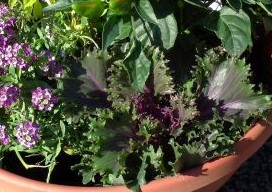
'Glamour Red' - "kale" type, uniquely different with its very shiny leaves, without the dusky, waxy look of other varieties. This intensifies the colors of its fringed foliage. Only one color, red--so far. 10-12" heads. Another tough variety that does well for us here.
'Osaka' series - wavy edged "cabbage" leaves in a compact rosette create an elegant appearance. 10-12 inches wide.
'Nagoya' series - a round kale type with heavily crinkled leaves and tight rosette centers that range in color from fuchsia pink to lavender to yellow green to creamy white.
'Crane' series - ornamental kale type with smaller rosette heads that include cabbage, ruffled cabbage, and feathery types on a longer stem, usually used for cut flowers. These grow 2-4' tall. In red, rose, white and bi-color. To heighten the effect, remove the lower leaves once it reaches 6" in height. May need staking.
'Chidori’ series - a mounded kale with purple foliage, extremely curly leaf margins and cream white or deep magenta center.

